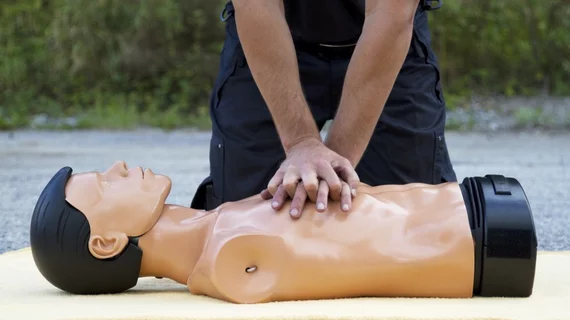How one hospital is perfecting mechanical CPR in the ED
On a biweekly basis, researchers and physicians at the Feinstein Institutes for Medical Research and North Shore University Hospital in New York gather to watch footage of patient resuscitations.
It’s a team-based learning exercise designed to help hospital staffers improve on their ability to mechanically resuscitate cardiac arrest patients—and, according to results published in the Journal of the American Heart Association March 10, it’s working.
“It was a simple yet powerful idea—use overhead video cameras to record and then later review the process of our staff administering mechanical CPR in our emergency rooms to improve outcomes,” research lead Lance Becker, MD, said in a release. Becker is the emergency department chair at Long Island Jewish Medical Center and NSUH.
“Our data support the benefit of actively reviewing and improving on real-world CPR techniques to save peoples’ lives. When we saw a problem we developed new protocols to overcome each challenge.”
Since less than 8% of people who suffer a cardiac arrest outside of the hospital survive the event, Becker and colleagues said it’s paramount that, when people who do make it to the hospital, ED staff are well-equipped to save lives. The team’s study launched in 2018, at which point ED staff at NSUH began recording the process and use of the mechanical chest compression device (MCCD) for cardiac arrest patients.
Four resuscitation rooms in total were equipped with video review technology and monitored 151 cardiac arrest patients for their return of spontaneous circulation (ROSC) rate pre- and post-intervention. Becker et al. dubbed their approach Mechanical, Team-Focused, Video-Reviewed Cardiopulmonary Resuscitation (MTV-CPR).
During each team meeting, Becker and his team of physicians, nurses and technicians would gather to analyze resuscitation videos, reviewing their processes and looking for ways they could improve on each patient. The method allowed Becker and colleagues to implement personalized feedback for staff who might be placing MCCD on patients; reduce chest compression interruptions; develop new assignment roles for an eight-person response team; and create coordinated transition methods for smoothly moving from manual to mechanical CPR.
“Dr. Becker and his team have led early national efforts to put defibrillators in public spaces,” Kevin J. Tracey, MD, president and CEO of the Feinstein Institutes, said in a statement. “Now they are leading this new effort to prevent sudden cardiac deaths in hospital emergency departments.”

